QuestionIhave a large dog.A cross between a golden retriver and a rottie, and soe other breed. The problem is every time I try to bring him in sooner or later he will pee somewhere in the house. I have tried everything that I know. He has been fixed and is abou 8 years old. Please help
AnswerHi Philip,
Thank you for writing to me about your dog's housebreaking problems. So sorry for the delay but we have had cable problems in our area due to the excessive rain.
There's no such thing as an almost housebroken dog. Either your dog is or isn't housebroken. When a dog is housebroken he never uses the house for his toilet, so I suggest that you go back to basic puppy housebreaking, even though your dog is all grown up.
Many people do not understand why their dog does not know what to do when taken outside. Just turning a dog out in the back yard by himself a few times a day for a few minutes is not the way to house train a dog.
Merely taking him outside also does not mean he knows what he's being taken outside for. The biggest problem between your dog and yourself is that your dog would love to please but he doesn't know that you are displeased with him going to the bathroom in your house.
Housebreaking in theory is very simple. It is a means of preventing your dog from doing his business in the house and only giving him the opportunity to do it outside. It also means that your dog learns to communicate with you about going when told to go and about letting you know when he has to go outside.
A dog is a creature of habit and because he learns by association, if his training is consistent he will quickly learn there is no other place to relieve himself other than outdoors.
We take advantage of a very natural instinct of a dog - his desire to keep his sleeping quarters clean - i.e. not to mess his bed. We offer a dog a den in the form of a dog crate or if your dog at this age is not crate trained, then offer him a restricted are or else you will have to leash him to a door knob or table leg. Make sure that there is nothing around that he can get entangled in. This area becomes his bed that he cannot get out of. If his dog crate or restricted area is the right size he will not soil it.
Dogs are and always have been den and pack animals. Canines naturally and instinctively prefer the shelter of a den. In the wild the young are raised in dens. They spend a great part of their first year very close to their den. In homes, dogs often choose their den. They will get under a
desk, behind a couch, in a closet. ect. etc
A dog crate is a perfect, natural bed for a dog and a safe, natural spot to put your pet whenever necessary for the dog's safety or the owner's peace of mind. However, if a dog isn't initially crate trained then you would have to do it with the assistance of a trainer so as not to traumatize your dog for life. This is extremely important.
Keep a bowl of all-natural dog treats near the crate. Every time you put your pup in the crate or restricted area give a "CRATE" or "BED" command and toss 3 or 4 liver treats
into the crate or area. It gives your dog a nice reason to go in. You will be surprised how quickly he expects to get a treat when he goes into his area. Going there becomes a positive experience.
As your dog ages and learns, give the "CRATE" or "BED" command before tossing the treats in. Expect your dog to go in on his own. This exercise is the beginning of teaching your dog to go to his area when people come to the
house. Dogs that bark and act stupid when they hear the door bell need to be told to go to their crate or bed. This is how that training is started.
When thinking of the size of a crate needed for your dog, think small. Think den not condo! The use of too large a crate for a dog will encourage your pet to use a small portion of it for a bed and the remainder as a relief station! Your dog, if using a crate should be able to stand up and turn around with a bit of room to spare.
Your puppy should only be allowed to relieve himself out doors.
A crate or restricted area is never meant to be used as a place of punishment for your dog, so a couple of safe toys would be welcome for down-time. A kong filled with peanut butter or cream cheese goes a long way towards keeping a dog
quiet in a crate. Be careful of the toys you choose to leave - soft squeaky toys with bells are not healthy for dogs. Too often dogs chew up these soft toys and get parts of them stuck in their bowels which often kills them.
Start crate training while you remain in the same room with your crated dog, frequently praising him and letting him know clearly it is pleasing to you that he remains in the crate, quietly. Frequent trips out of the room with quick returns with a treat through the bars will condition your
dog to your comings and goings.
Gradually extend your absent periods, and in a short time, you can be gone several hours. While in the crate, your dog should not be scolded.
Crate confinement works so well that most dogs soon choose the crate for naps and, in general, consider it their own private domain. They learn that they can go into their crate and sleep and no one will step on them or jump on them. Feed your dog in his crate as well.
If you are in a protected area (a fenced back yard) let your dog go free of the leash. Be sure to stay out there with him. Lavishly praise him with GOOD BOY when he has completed his duties. Take him inside at once and put
him in his restricted area.
A puppy or untrained dog is NEVER ALLOWED TO HAVE FREE ACCESS TO THE HOUSE unless you have your eyes on the him. If he poops on the floor because you turned your
back for 45 seconds - you made a mistake, not your dog.
The only time pups can be loose inside is just after they come in from going outside and then only for short periods of time. NEVER leave a dog unattended and loose in the house until it is completely housebroken.
Pups must go out first thing in the morning (and I mean first thing) take your dog outside. He's been clean all night - and holding it all night -he will do his business in a hurry because HE HAS TO GO. Now bring him in and give him freedom, but in the kitchen only. A child's gate at the kitchen doorway is an excellent barrier to the other rooms in the house. Give him freedom while breakfast is being prepared and while you are eating breakfast. After your breakfast, and when you have time to take him
out, feed him breakfast - and take him out immediately. Remember the rule - outside after each meal. Do not leave food or water down or he will do his business immediately afterward, when you aren't there to take him out. Dogs relieve themselves after SLEEPING- EATING AND HAVING
EXERCISE.
Now bring him in and put him in the restricted area and go about your normal routine of the morning. He should stay in the crate until about 11:00 to 11:30A.M. Then out of the crate and outside. Bring him in, and while you are
preparing and eating lunch let him have the freedom of the kitchen but only when you have "eyes on your dog".
At dinner time as soon as he has finished his last mouthful - take him outside. After he has completed his business, bring him in and again give him the freedom of the kitchen while you are preparing dinner and during
the dinner hour. Give him another trip outside about 8:00 P.M. - and again just before your bedtime. Some pups need to be exercised more than others to get them to relieve themselves. Exercises always increases the urge to
pee or poop. Keep your dog outside for up to 30 minutes to insure that he will go. Prevention is the key to success.
The bottom line is you cannot take your dog outside too much. If you take him out every 3 hour then he learns that he is going to have a chance to go outside to do his business. So when someone tells you to wait for 4
hours - I would ask WHY if you can take him out more often? Why wait that long if you are home. We want to establish a pattern and what better way than to take your dog out all the time. Also do not underestimate how important it is to ask your pup if he WANTS TO GO OUTSIDE just before
going out and praising GOOD BOY when HE DOES GO.
One last point on your dogs house breaking. A commercial kibble diet takes 14 to 15 hours to go through a dog. An all-natural diet goes through the dog in 5 to 6 hours. I strongly recommend that you consider doing your
research on all-natural diets.
A couple of points on how to housetrain your dog:
1. Do not vary your dog's diet.
2. Snacks or treats are forbidden.
3- Bring him in as soon as he does his business.
4- Praise every time you see him pee or poop. Do this forever. Reinforcing good behavior never hurt anything.
5- Dogs who go out and just dink around and then go in their crate need more exercises when they go outside. A long walk will often cure the problem. BE SURE TO PRAISE -then when you have your dog in the house and say "DO YOU WANT TO GO OUTSIDE" he will learn what you mean.
6- Older dogs are house trained exactly like young pups.
Using An Odor Neutralizer And Indoor Spray Repellent. I like using Nature's Miracle, peroxide, vinegar and alcohol.
When a handler makes a mistake and allows a dog to pee in the house, you have to get rid of the odor. This is accomplished with an odor neutralizer, which is available in pet stores or you can try using
straight vinegar. (Do not use household cleaners as they contain ammonia and will attract him back to the same spot.) When used properly it will completely eliminate these odors, discerned only by the dog, by neutralizing the scent. When areas previously used by your dog have been
neutralized the incentive for using the same spot will be eliminated.You can purchase a black light to find old pee spots in your house.
Proper Correction
Under no circumstances should your puppy be punished for relieving himself in the house, unless you catch him in the act. The punishment should be a verbal scolding not physical harm.
A puppy has no mental capacity to connect your wrath with whatever he did wrong, even a few minutes earlier. If you cannot get to your puppy while he is doing his business then you have screwed up. Pups simply cannot put two and two together to understand why you would be mad about him peeing on the rug. It is confusing to him and you only get a puzzled whimper.
Catch him in the act or scolding is no good. I don't recommend scolding at all but only prevention as it is not his fault at all.
The old adage of rubbing a dogs nose in it is stupid. We don;t do this to our kids and we should not do this to our dogs. Anyone who recommends this needs a good swift kick.
Many people are mistakenly convinced that a dog messes in the house for spite or revenge, usually for having been left alone. This is incorrect. It is for reasons of anxiety, nervousness or fear that he behaves this
way...or simply that he is not properly housebroken. Very often the owner comes home and finds the dog behaving in a fearful, shameful, or generally guilt-ridden manner. It is because of this that the owner is convinced the dog has messed in the house for spite. It's simply not true. The dog
cringes when you come home because he associates your arrival with punishment. YOu have conditioned him (and it only takes ONE TIME) to be afraid when you came home in the past.
Are you picking the water up at 6:30?
Are you giving your pup enough exercise to make him tired before he goes to bed?
Are you putting your pup in his restricted area all the time and not just bedtime. Your pup needs to learn that he must go in his area and calms down.
If you are convinced your pup just wants to come out and play after a few hours , then ignore him or take him out for some exercise. If there is a mess in the crate later on - then YOU MADE A MISTAKE - not your dog.
With a little effort on your part and the use of this method your dog can be housebroken very quickly. But remember there is more than peeing and pooping in the house that goes along with housebreaking.
House Training :
House training should only take approximately two weeks to establish as a routine provided;
a) you must be consistent and committed
b) you are prepared to train your pet. Have a leash, collar, a designated area and are prepared to maintain a
schedule.
Retraining a dog that has already established bad habits can take six weeks or more.
As soon as possible get your dog to the vet for a complete check-up. This will assure you that you have healthy and alert you to any medical complications that can make house training more difficult.
Situations such as intestinal upset, intestinal parasites and urinary tract infections can make house training difficult to impossible.
The designated toilet area can be as general as outside of the house or as specific as a particular corner of the backyard. You must have a specific plan as to what the designated area is going to be. You can not teach your
dog what is acceptable if you are uncertain.
Your attitude is one of the most important ingredients in house training your dog. Your puppy does not know what is wrong. If there is a mistake tell him "no" but do not discipline too severely. You only want him to know that you are displeased, you do not want your pup to feel that you are the source of pain.
When your pup has done well, pat him, praise him, let your dog know that you are very pleased. Your pup will want to do things that please you.
House training can be a foundation for all future training. Affection and praise as a reward for proper response - "no" signaling displeasure and guidance to show your dog what you do want.
Scheduling:
1. Create a schedule that is practical for you to maintain. If you can not stick to your schedule - you can't expect your dog to adhere to it.
2. Do not allow your dog to free feed until house training is well established. Be very careful of your dogs diet - avoid foods and/orsnacks that can be upsetting to his digestive tract.
3. Schedule your dog's bed time and waking-up time. Adhere to these times as closely as possible.
4. Remember that your pup will need to be taken outside after each feeding or drinking.
5. Emotional intensity - after intense emotional stimulation (badly scared, frightened, or a particularly rowdy play session) your pup may need to relieve himself.
6. Within two to three days, most dogs will be able to "control themselves" for eight hours during the night. You must keep in mind that your daytime schedule will need to be somewhat flexible.
Supervise in the House :
1. By knowing where your dog is at all times, and what he is doing, you can avoid mistakes. When a pup stops playing and starts to look around for a "good spot", he needs to go out. By observing your dog you will quickly learn to tell the difference between the pup's exploring his universe and his searching for a "good location".
2. If your pup starts to make a mistake, firmly but quietly say "No" and take him straight to his toilet area. Do not yell at your dog. Do not chase your dog. At this point it is up to you to be observant of your dog. Any mistakes that are made are due to your not paying attention.
3. If you can not supervise your dog for a period of time, put him in a confinement area (prepared with papers) or confine him to the room where you are.
4. When you are relaxing (watching TV, reading or on computer), have your dog with you. Give him some of his toys to play with. Have your dog on a leash or confine him to the room where you are, so that he doesn't wander out and have an accident. Teach him that it can be enjoyable just being with you. When you can't be with your dog:
1. Provide a small area confinement area (bathroom with all "chewable" items removed, fenced off area of the garage, or a crate).
2. Do not leave food and water with your dog, or fill his area with cookies or snacks before you leave. You should schedule your pup's breakfast to be at least 2 hours before your planned departure time. That way he can
eat, digest his food and relieve himself prior to your departure.
3. Ideally, if you are going to be gone for more than eight hours, someone should give the dog a drink and an opportunity to relieve himself several times during the day.
Taking your dog out:
1. Take your dog on leash to the designated toilet area. Stand quietly, so that he can find the right spot. Do not distract your dog. Do not praise him during his search. If after about a time your dog hasn't gone to the bathroom, return him to the house (keeping a close eye on him) for
about 1/2 hour, then try again.
2. When he does go, calmly praise him. Use a chosen word or phrase (good potty, etc). This phrase will only be used for praise in going potty.
3. When your dog has finished relieving himself praise him very enthusiastically. Let him know that you are very proud of him.
4. Remember your dog's routine. Some dogs will "potty" two or three times per outing in the morning, but only twice per outing in the evening. Urination is often followed by defecation, while other dogs will do the reverse.
5. Even if the weather is foul, do not let your dog know that you don't want to be going outside with him. By teaching your dog that even in bad weather going outside is "the thing to do", to please you, then he will be
more willing to convey his needs to you.
6. While you are learning your dog's "time table", take him out immediately after he wakes up, after he has eaten and after all play sessions.
Catching your dog "in the act" :
1. Without yelling, firmly say "No". If you still don't have your dog's attention, clap your hands.
2. Get your dog outside, to the designated latrine area. If your dog relieves himself outside praise him. Proceed with the potty routine.
3. Clean the mess with a deodorizing or odor killing cleanser or vinegar. If your dog smells his own scent as having been used as a bathroom area, he will continue to use the area.
If the cleanser is not able to eliminate enough of the scent so that your dog can not detect it, you can help mask the scent over with vanilla extract. Just one or two drops will make it impossible for your dog to smell any lingering odor.
II wish you all the luck with training your precious dog.
Best,
Shelley Davis
www.bednbiscuit.com

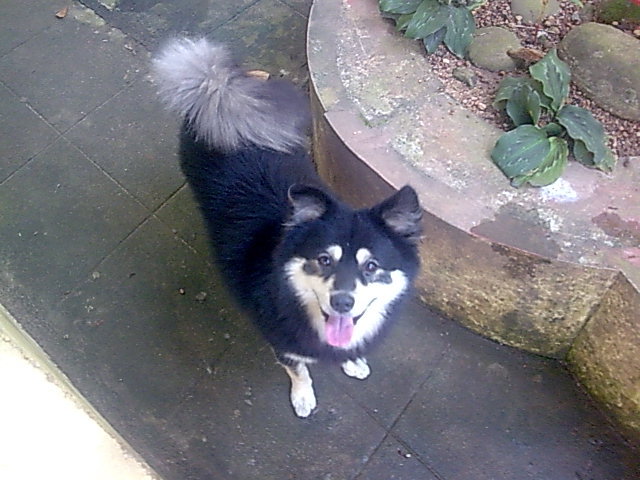 pooping and peeing
Question
snoopy
hi, my name is praveen n i have a dog t
pooping and peeing
Question
snoopy
hi, my name is praveen n i have a dog t
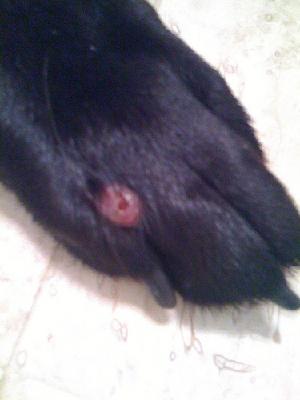 Redish bump between dogs toes
QuestionHello I have a three year old Australian Shephe
Redish bump between dogs toes
QuestionHello I have a three year old Australian Shephe
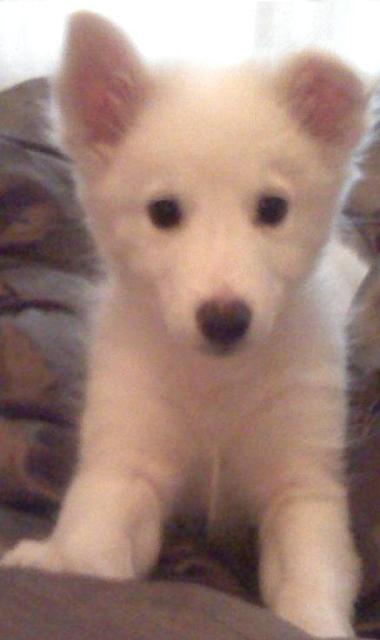 New Eskimo puppy
Question
Honey the shy american
I just got my 10 week o
New Eskimo puppy
Question
Honey the shy american
I just got my 10 week o
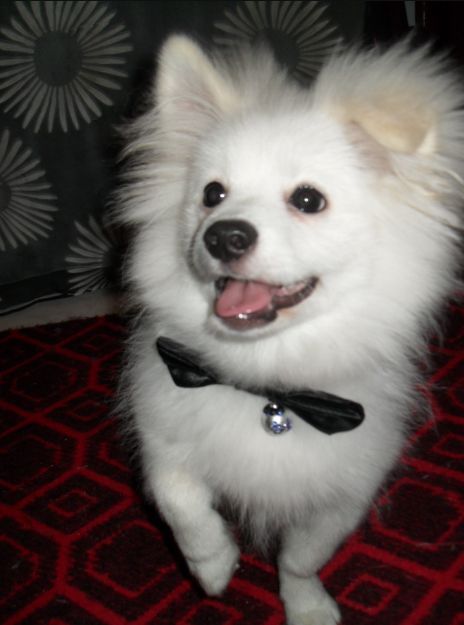 Dog Breed.
Question
Recent photo this week
Hello,
I saw that you
Dog Breed.
Question
Recent photo this week
Hello,
I saw that you
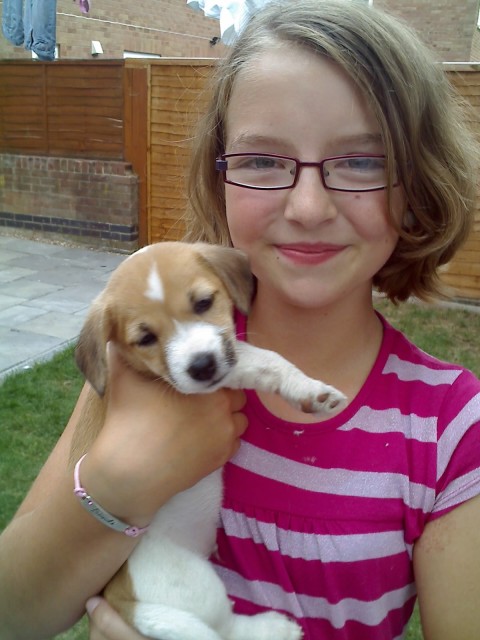 Puppy hates being alone.
Question
Me and Toby
Our jack russel is extremely cuddl
Puppy hates being alone.
Question
Me and Toby
Our jack russel is extremely cuddl